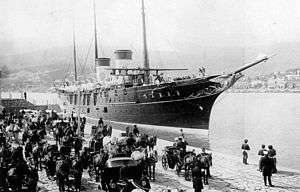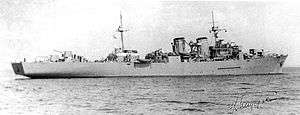Russian yacht Standart
 Standart arriving at Yalta, The Crimea | |
| History | |
|---|---|
| Name: | Standart |
| Namesake: | Emperor's Naval Standard |
| Owner: | Imperial Russian Navy |
| Ordered: | 19 June 1893 |
| Builder: |
|
| Yard number: | 183 |
| Laid down: | 1 October 1893 |
| Launched: | 10 March 1895 |
| Commissioned: | September 1896 |
| Decommissioned: | 1918 |
| Name: | Minelayer Marti |
| Owner: | Soviet Navy |
| Reinstated: | 1936 (as minelayer) |
| Fate: | Scrapped 1963 |
| General characteristics as Imperial Yacht | |
| Displacement: | 5557 tons standard |
| Length: | 128 m (420 feet) |
| Beam: | 15.8 m (52 feet) |
| Draught: | 6.00 m (19' 8) |
| Propulsion: | 2 Triple Expansion Steam Engines |
| Speed: | 21.18 knots |
| Complement: | 355 |
| Armament: | 8 - 47 mm (1.9 in) guns (Hotchkiss) |
| General characteristics as Minelayer Marti | |
| Displacement: | 5665 tons standard, 6198 tons deep load |
| Length: | 122.30 m (401' 3) |
| Beam: | 14.4 m (47' 3) |
| Draught: | 6.80 m (22' 4) |
| Propulsion: | 2 shaft, 2 Triple Expansion Steam Engines, 4 boilers |
| Speed: | 18,85 knots |
| Complement: | 400 |
| Armament: |
|
The Standart was an Imperial Russian yacht serving Emperor Nicholas II and his family, being in her time (late 19th/early 20th century) the largest Imperial Yacht afloat. After the Russian Revolution the ship was placed in drydock until 1936, when she was converted to a minelayer. During World War II, she participated in the defence of Leningrad.
History
Imperial Yacht
The Imperial Yacht Standart (Штандартъ) was built by order of Emperor Alexander III of Russia, and constructed at the Danish shipyard of Burmeister & Wain, beginning in 1893. She was launched on 21 March 1895 and came into service early September 1896.
Standart was fitted out with ornate fixtures, including mahogany paneling, crystal chandeliers, and other amenities that made the vessel a suitable floating palace for the Russian Imperial Family. The ship was manned and operated by a crew from the Russian Imperial Navy. During the reign of Nicholas II, Standart was commanded by a naval Captain, although the official commander was a Rear Admiral. Her commander in 1914 was Nikolai Pavlovich Sablin.
In 1907, Standart ran aground on an uncharted rock off the Finnish coast. Although damaged, the ship did not sink and was repaired and soon returned to service. The Russian Imperial Family was vacationing on the Standart during the summer of 1914, when they received the news of the assassination of Archduke Franz Ferdinand, in Sarajevo. With the outbreak of World War I, Standart was placed in drydock.
.jpg)
Soviet Minelayer Marti

After the fall of the Romanov Dynasty, Standart was stripped down and pressed into naval service. The ship was renamed 18 marta (18 March), and later Marti. In 1932-1936, Marti was converted into a minelayer by the Marti yard in Leningrad. During the Second World War, Marti served in the Baltic, laying mines and bombarding shore positions along the coast. On 23 September 1941, Marti was damaged in an air attack at Kronstadt, but later repaired and continued service until the end of the war. A mine laid off Hanko by Marti sunk the German submarine chaser UJ.117/Gustav Kroner on 1 October 1941.[1].
After the war, Marti was converted into a training ship and renamed Oka in 1957. She continued serving in that role until she was scrapped at Tallinn, Estonia, in 1963.
Specifications
- Displacement: 5557 tons
- Length: 370 feet (112,8 m) between perpendiculars
- Length Overall: 420 feet (128 m)
- Width: 50 feet 8 inches (15,8 m)
- Depth: 20 feet (6 m)
- Maximum Speed: 21.18 knots
Previous Imperial Yachts
- Alexandria (Александрия)
- Livadia
- Polyarnaya zvezda (Polar Star - Полярная звезда)
References and external links
![]()
- Russian Imperial Yacht Standart
- Royal Russia - Russian Imperial Yacht, the Standart
- Conway's All the World's Fighting ships 1922-1946
- Specific
- ↑ Donald A Bertke,Don Kindell,Gordon Smith (2012). World War II Sea War, Vol 4: Germany Sends Russia to the Allies. p. 310.